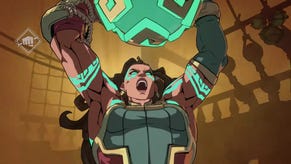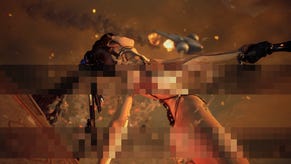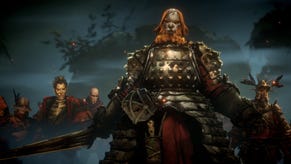Fable The Journey interview: road trippin'
Fable: The Journey is another chance for Microsoft to prove Kinect's motion control chops. VG247's Dave Cook speaks with Lionhead Studios to learn why this could be the game to do it.
Microsoft used to talk big game over Kinect before it launched. The promise of immersive worlds and intuitive, natural motions that translated flawlessly from mind, to limb, to screen filled the futurists among us with wonder and whimsy. The future was coming, and it looked good.
Once Kinect launched however, the actual experience of sitting down to play it left many of us feeling cold. The peripheral has sold well however, and certainly still has its fans, so it can hardly be called a failure from an economical standpoint. There's one thing that many of us are still forgetting however.
Controllers as we know them today didn't magically appear in their current state. Creating solid, dependable, and ergonomic control methods is an iterative process that has taken many years - and in the grand scheme of things - Kinect is still a young pup in a world dominated by seasoned control methods.
It's still early days, but you can already see a stark leap forward in both responsiveness and creativity in Fable: The Journey, Lionhead Studio's crack at the motion-controlled market.
VG247 had a chat with the Fable: The Journey's lead designer Ted Timmins to find out more about the game's development, and the role of motion control in the industry today.
VG247: Lionhead has been steeped in motion control tech long before Kinect was even revealed. Can you tell us a little more about where the concept for Fable: The Journey came from, and if it has always existed in its current form?
Ted Timmins: Yes to the last question, it is pretty much how it always has been, at least in the sense of the high level design of casting magic and riding around the world in a horse and cart.
Our creative director Gary and his team – prior to doing Fable the Journey – had been doing Milo & Kate, and they'd spent a good couple of years developing that and just getting a great understanding of what Kinect does really well.
When we switched to the idea of using Kienct for a Fable game, they had all of the experience that they had learned through development of Milo & Kate, and all of the technology – such as the ability to play while sitting on a chair.
They were able to take all of that and apply it to Fable: the Journey. Combined with things like the horse and cart, which feels very intuitive and natural – and is something you don't get on a controller – it all came together very well on Kinect.
Plot-wise, this feels like a more personal story than previous Fable games. Was that an objective of the team early on?
Yeah, we wanted to tell a story that was slightly different to previous Fable games. Previous games had always been about a generic template hero, and you grow them to be whatever kind of hero you want to be at the time.
But with Fable: the Journey we thought it would be really interesting to tell the story of someone else, someone who you can relate to, someone who has a history, has a future, and have a present. It's someone we want you to learn more about as you go along.
So the character Gabriel that you play as, he's got a really interesting past. He's not part of a heroic bloodline, he's not any particular hero, and he comes across Theresa who has obviously had a really big presence throughout Fable in the past.
From there they go on this amazing journey, and in terms of the timing it's actually set 50 years after the events of Fable 3. So if people wanted to look at it in a timeline sense, then that's where it fits.
I think maybe two weeks ago we actually released a novel called 'Edge of the World, and that novel along with the game helps describe some of the things that have happened to Albion in that 50 year period.
Within that narrative, will we see any returning characters besides Theresa?
We wanted to tell the story of Gabriel, and the reason we picked Theresa as our focus point was that – at the end of Fable 3 – it was funny when we were reading on forums, because our fans are so vocal and so great when it comes to giving us feedback.
They were like, 'Theresa was more mystical than ever in Fable 3, why is she 500 years old? You never know if she's being good, or if she's being evil. Why is she making me make all these tough decisions?' So we really wanted to focus in on her, as well as Gabriel, to tell her story.
Many of the scenes in the game really delve into her backstory, and there will be other returning characters, and there will be obviously the creatures as well – Balverines, Hobbes, Hollow Men and Trolls – they all make a comeback, but not to the same extent as Theresa and Gabriel. We really wanted to try and focus on this duo, and to tell each of their stories together.
One of the interesting sections – certainly story wise – we played today was when Gabriel enters an ancient cave and you get all of this backstory about the Hero bloodline that you never had before, and then you learn how to use magic, which actually works really well once you get used to it. How challenging was it to get combat to work properly?
That's been the most challenging part, without question. Although I haven't been one of the designers on that particular area, I have worked with the design team, and they have had a terrific job to do.
Many of the gestures are based on actual motions. So you may have already noticed that when a rock is thrown and it's coming towards you, we get you to put your arm across your chest to deflect it. That's because early indications were that if we base gestures on natural motions, then people would relate to them and understand them.
You're not pressing the A button. If a rock is coming in you need to put your arm up, which is again a normal thing you'd do to shield yourself. Leaning left or right to strafe, casting spells by using a dart-throwing motion – these are are all very intuitive gestures.
We have been through and made a lot of different gesture-based systems, and I really feel that we've found the one that clicked and that worked the most. The magic system is really the key, and I think you ask many people around here what parts of the game they're most proud of, it would be the story and the magic.
It's interesting that you want to make the motions feel natural and intuitive because – certainly on the Wii – we've seen a glut of third-party games with motion tacked on.
Yeah and look {points to the Zelda t-shirt he's wearing]. I'm a massive Zelda fan, but Skyward Sword just didn't do it for me. I mean I loved the gameplay, but there were times where ugh...damn...I don't know how to describe it [laughs].
There were times when the game asked me to do something in motion and it didn't work. I think that's when you break down the immersion, like, you're really immersed in a game then all of a sudden it says, 'do this!' and it doesn't work. Then you realise, 'oh hang on, I'm not a hero, I'm playing a videogame.'
Very early on, when we were developing this, we realised that people are going to miss when firing a spell from time to time. So we made it that if people do miss, they can bring it back in using aftertouch, and that way you never lose that sense of immersion.
Because in your head you're thinking, 'no matter where my spell goes, I can bring it back', so that was a really important feature for us to have.
The systems at play here are intricate and they do work very well. It's impressive, but would you say there is still untapped potential in Kinect that we're yet to see?
Oh without question. I mean, I also wouldn't claim that we've achieved this without the assistance of anyone else. We've had Rare help us out – They've obviously got years of Kinect experience as well – and it's not just that we've had other teams help us, but we also play a lot of Kinect games.
We're fortunate that Fable: The Journey is 'wave three' I guess you could probably say? So we've played 'wave one' and 'wave two' games, and we've also had the opportunity to see games that perhaps had systems that didn't work as well as they should.
So not only have we learned from internally developing our own systems, but also from working with other studios, playing other people's games and I think that has really led to Kinect starting to become something that is...well like a control pad.
If you look at the first control pad on the NES: it's just two buttons and a d-pad. But then over time it started to evolve, and I think with Kinect - even though the hardware hasn't changed – in the background the software is really starting to evolve.
Games like Nike+ let you lie down and it will still detect you. That's a first for Kinect. So we're definitely at the tipping point now where Kinect is starting to break out into new areas.
What sort of key areas would you like to explore next to try and really push what Kinect games can do?
Jesus, that's a really good question. Really, I think it's just about continuing to break down barriers, such as Kinect always doing what you want it to do, and that's always going to be a tough barrier with anything like, phones that have touch screens, games that have motion, or hardware that uses voice recognition.
These are all things that, unlike a button, sometimes don't work all the time and I think that's the thing that really needs to be improved. So whenever a user inputs a motion command or touch, it's important that it has to work.
That's the hardest part to do because you've got to make the hardware get into the head of the person who's playing, and I think if we can break down that barrier – I think that might take a couple of years, or longer – you reach that point where it becomes a lot easier for us to keep the player immersed.
Part of that immersion is to also keep people interested in the game as it goes along. How long is Fable: the Journey and how do you dole out new motions and features as the plot progresses?
That's a question that sort of ties in to why we chose to have players sitting down while playing. This isn't 'Fable: Minigames'. It's a Fable game, it has a story, it has characters, it has creatures and really we wanted you to sit down because for 15 hours – we kind of think anywhere between 12-15 hours is the playthrough time.
You haven't seen Arcade Mode yet, but that is an add-on at the end. So when you complete the game you can do like high scores and things like that. Really, that's why we wanted you to sit down, because it's a long game, especially if you're asking someone to sit down for 15 hours. That would have been too much to ask.
That's good to hear because a lot of people say Kinect games aren't like full games. But when you take something like the previous Fable games – or any game set in a big world – you couldn't really use Kinect to navigate in the same way as you would with a controller. But that's perhaps the industry's next challenge with motion isn't it?
Yeah, and if you look on YouTube, I've seen many cool Kinect mods, particularly one for Skyrim. When Skyrim came out someone did a Kinect mod for it, and it was really cool. The Wii went through a similar phase when that came out, of people making up their own little software things for it.
There's definitely potential there for sure. I think as soon as barriers begin to be broken down, it's like – our creative director Gary has said this before – when the keyboard and mouse came out, people questioned it. But now it's commonplace, and I'm sure Kinect will take the same route because motion technology is a part of the future, as much as it is part of the present.
Looking forward then, what would you like to see from next-gen hardware in general that could make motion control take another leap forward?
I think, for me, I guess the Wii and Kinect has proved that you don't always have to go for more horsepower. You can go wider, you can improve on what you have and look at new input methods, and I think that - regardless of what new hardware in the future holds – I think it's going to be about how developers like ourselves make software and control bond.
The Xbox 360 is a great platform to develop on, and that's the key – to make a great platform that people can develop and work easily on. The two main things are, in summary, more horsepower and to refine what we have.
Don't get me wrong, I like horsepower as much as the next person, but sometimes it's about getting what you already have right first, then to give developers a platform they can use to push innovation forward. We shouldn't fixate so much on polygons, pixel count or anything like that.
Xbox as a platform – much like Sony – does have an umbrella of developers who do collaborate, share tech and work to get the best out of the format. How valuable is that collaboration?
It's incredible, it's like taking our team of 150 at Lionhead, and basically multiplying it by two. It's knowledge, it's experience, it's all these different things that – when you're running up to completing a game, you can't always hire another 150 for.
But if you reach out to another studio - obviously there's people like Turn 10, 343, Rare,and I mean the list goes on – we don't make a big song and dance about it, we just get it done. Maybe we should make a bigger deal out of it? [laughs].
But yeah the guys at Rare are great, getting Phil Harrison on board at Microsoft has been great, and so many others have done a brilliant job of just giving things a push.
Sometimes you need that, to just say, 'hey guys, you're making a Kinect game, we've made Kinect games. Let's talk.' So we go into a room and we talk. It's a relationship that will continue to develop on future titles I'm sure.












